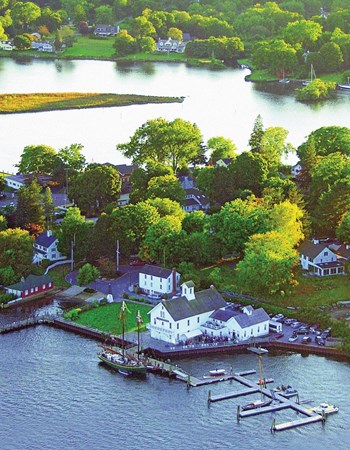
Nestled just off the Long Island Sound halfway between New York City and Boston, Essex is a colonial hamlet resting on the banks of the Connecticut River.
This diminutive town – population just over 6,700 –is actually composed of three small villages: Essex Village, Centerbrook and Ivoryton. Essex has the dubious distinction of being one of the few American towns to be attacked by a foreign enemy in wartime. After being bombarded by the British in the War of 1812, Essex has remained decidedly under the radar. Foregoing its brief role as a player in industry and world affairs, modern Essex has distinguished itself most notably as a wonderful place to live; a quiet and quintessential New England town.
A Rich History
When one talks of Essex, one talks of history. Each of the villages has played an important role in the growth of the town over its 300-year history. The region that would evolve to become modern Essex was originally settled as the Saybrook Colony in 1635. The colony became part of the state of Connecticut soon after, and was divided into formal settlements in 1648. Although there was some early trade between Essex and the Caribbean, the area remained sparsely populated and overwhelmingly agrarian until thebeginning of the eighteenth century.
Benefiting from the fertile land along the mouth of the Connecticut River, the village of Centerbrook, quite appropriately, was the center of the town during this early period. Dams on the stream that bisects Centerbrook allowed for the development of various mills, which further supported early commercial growth. To this day, Center-brook has many excellent examples of historic farmhouses from this era; the Selah Gris-wold House, the Clark Nott House andthe Benjamin Bushnell Homestead are among the best preserved.
The area finally achieved sufficient population to support the construction of a Congregational church in 1727. Built in the village of Centerbrook, the church was rebuilt in 1790 and currently has the distinction of being the oldest church in Middlesex County.
From Shipbuilding to Piano Keys
The American Revolution brought new opportunity for the area; the war markedly increased the demand for sea-going vessels. With its many protected coves and ideal geographic location near Long Island Sound, Essex Villagebecame a center for shipbuilding in the middle of the eighteenth century.
Between the American Revolution and the Civil War, over 600 large sea-going vessels were made by hand in Essex. It was the town’s prominence in the shipbuilding industry that led to the attack in the War of 1812. In this “Pearl Harbor” of the era, the British attacked the port and destroyed28 ships, a significant and shocking financial loss. Local lore claims the British didn’t burn the town itself because a town merchant greeted the commander of the enemy fleet with a secret Masonic handshake.
Another local legend claims the town was spared because the British soldiers wanted to stay at the Griswold Inn, which is still in operation today. Despitethe attack, Essex Village rebuilt and continued as a shipbuilding center for several decades, with six active shipyards at its peak output. Because the area prospered largely during the early 19th century, many of the prominent historical homes and shops on Main Street in Essex Village are Federal-style architecture.
After the Civil War, the demand for wooden war and cargo ships declined. With the decline of the shipbuilding industry, focus shifted from Essex Village. At this point manufacturing became more important economically and Ivoryton became the leading commercial sector of the area. Ivoryton, aptly named, was mostly known as a leading producer of ivory and ivory products in the second half of the nineteenth century. Until the middle of the 20th century, virtually every key on every piano in America was made inEssex. Eastern European immigrants flowed to the area to work in the new factories, temporarily changing the economy and demographics of the region.
Factories Closed or Consolidated
Following World War II and the advent of the radio, which diminished home piano playing as a source of entertainment, demand for ivory declined. As in much of New England, factories consolidated, closed or relocated. At the same time, interstate highways and improved train lines helped make Essex more accessible andappealing as a bedroom community. Location and lifestyle became the draw of the town.
The past is not forgotten in Essex, however. Preservation of historical buildings, marinas and homes played an essential role in transforming Essex from a manufacturing center to an elite residential community. Thanks to zoning laws historic homes, shops on Main Street, winding roads and even the mature trees of the area have been beautifully preserved.
The past is also responsible for some of the biggest attractions in Essex. The Valley Railroad, a vintage steam train retrofitted to take tourists up and down the line while feeding them an old-fashioned dinner, is one of the most popular attractions in the region. Visitors are also drawn to the Griswold Inn, known locally as “the Gris,” which has served guests since 1776, a maritime museum and something few towns can claim –a “top notch” fife and drum museum. The Copper Beech Inn in Ivoryton is also another popular bed and breakfast and fine dining establishment, and the Ivoryton Playhouse is a regional theater that produces 8-12 plays and musicals each year. (In its heyday, nearby resident Katharine Hepburn was often featured on its summer stock stage).
Not to be outdone by PunxsutawneyPhil, the town of Essex also sponsors an annual Groundhog Day parade. A large papier mache groundhog named “Essex Ed” is carried through town with revelers making noise in order to rouse him from his slumber and bring an end to winter.
There are businesses and services based in the Town of Essex, explains Matthew Fraulino of the Middlesex County Chamber of Commerce – primarily marinas, small shops and some light manufacturing. Most residents, however, commute to other towns to work.
People move to the area to live in a quaint New England village near the sea, yet still an easy drive to Hartford (40 miles), Middletown (20 miles), New London (20 miles) or New Haven (30 miles). Perhaps due to its distance from large urban centers, Essex has virtually no immigrant or minority representation. Largely white, wealthy and older, the town has a median income level and house values above the state average and unemployment and poverty rates well below the state average.
A Single Entity
Essex today is primarily residential. Although Essex has three villages, threepost offices and three zip codes, the town is increasingly viewed as a single entity. According to Jessica Graves, assessor for the Town of Essex, there are 2,428 residential buildings in the town, the majority of which are single family homes, with a few apartment complexes or multi-family buildings.
In addition, there are a total of 243 condominiums in the town. Maureen O’Grady, a realtor and owner of Rachel Thomas Associates, notes that most of the condominiums are concentratedin a few large complexes. “The real estate market as a whole is slow,” she explains, “but condominium prices have fallen more.”
Describing the average buyer in Essex, O’Grady explains that the area does not have large influxes or outflows of people. Because residents work in several cities and across various industries, the population is very stable. “People move in and they don’t move out. If they move, they just move to a different house.” Sales are likely to be people trading houses –either downsizing or buying a larger home.
At the moment, houses in the lower price range are selling best. In Essex, O’Grady explains, the lower range for a single family home is below $350,000. Sales are slow in top end of the market and slow in the middle range of the market, which is currentlyaround a half a million dollars for a single-family home.
Tucked away on the banks of the Connecticut River like a hidden gem, Essex is far from the madding crowd but close enough to Long Island Sound and Interstate 95 to attract a certain population. Affluent and older on average, the residents of Essex are commuters and boating enthusiasts, preservationists and historians, familiesand retirees.
Trading on its historic homes, tree-lined streets and picturesque marinas, Essex can also claim good schools, low crime and miles of sidewalks. Norman Rockwell might well have painted this little town, right down to the gazebo in the middle of Main Street Park.
Sarah Sanford is a freelance writer and a frequent contributor to New England Condominium magazine.






Leave a Comment